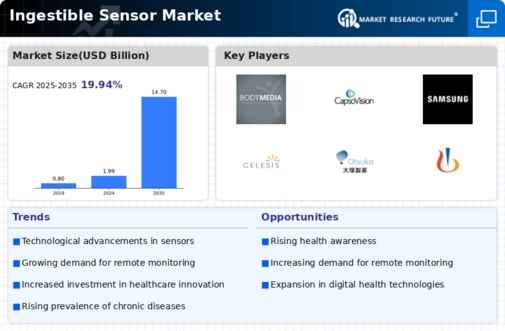Market Share
Ingestible Sensor Market Share Analysis
In the competitive landscape of the Ingestible Sensor Market, companies employ various market share positioning strategies to establish a strong foothold and gain a competitive advantageOne of the key strategies is differentiation via technological innovation. To produce new advanced ingestible sensors that have better capabilities and are more accurate, companies spend a lot on research development. Thus, through providing distinctive and modern features, corporations attempt to distinguish their products from others purposefully striving for a wider customer base as well approaching higher price levels.
The other important positioning strategy lies in strategic alliances and partnerships. In the dynamically changing environment, establishing partnerships with other actors within healthcare may serve as a way of increasing market share and improving product portfolio. Partnerships between ingestible sensor vendors, pharmaceutical firms and healthcare providers could give rise to wholesome solutions that address vast areas of health care monitoring. Such partnerships not only generate innovative possibilities but also produce synergies for all involved parties, thus helping to advance a stronger position in the market.
Price positioning is an essential strategy, especially in markets where price plays a key role for consumer preferences. Other businesses concentrate on obtaining production price advantages, which enable them to sell ingestible sensors at affordable prices. This approach is designed to compete for a larger market share by targeting price-conscious consumers. Conversely, firms focusing on a superior quality product with advanced features and more exclusive service may employ premium pricing strategies.
The second effective strategy for dealing with variety of consumer needs is market segmentation. Companies can create a niche in the Ingestible Sensor Market by identifying specific target demographics and designing products that meet their need. For instance, specialized sensor development for use in pediatric populations or markets such as the aged with chronic conditions enables companies to target unique niches.
Geographical diversification is a popular strategy that companies use to grow their market share. Recognition and entry into emerging markets with substantial potential can be an opportunity for growth. This approach requires a deep understanding of regional variations in healthcare demand, regulatory environments and consumer preferences. Future penetration into new markets will entail adaptation of marketing strategies, product assortments and distribution channels.
Strategic positioning and marketing are also important in determining the market share. Through effective marketing campaigns focusing on critical product features, building a brand image that provides reliability and innovation can shape consumers’ perception. A well-defined brand identity helps companies stand out in a crowded market and fosters brand loyalty, contributing to long-term market share sustainability.
















Leave a Comment